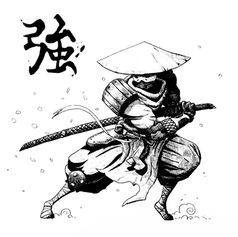
“No legion of steel and fire can surpass the strongest mind.”
-Kensei Sakamoto Hisaki
Biography
It is said that the samurai of the Seigun Shogunate were the most formidable and elite warriors among the mortal men. With precision, patience, resolve and a sword; a single Seigun could match the power of a hundred men. Despite their strength, it was stubbornness that caused their downfall. Unwilling to adapt to the modern age, they were forced to step down and reinstate a new shogunate. The mercenaries of the old clan either became ronin, monks, artists, or even farmers. But Hisaki Sakamoto—one of the greatest, most potent warriors of the past generation, would not allow his culture to fall so easily.
Sakamoto became a wandering teacher throughout Tekkan during the early years of the Tatsu Shogunate. Many he thought to be worthy refused his teachings, but some managed to carry the torch. In a matter of months, he had taught the sacred techniques and ideals to over a dozen pupils, but despite the efforts, he soon realized that the old ways could thrive in this country no longer. However, foreigners were not excluded from the way of the samurai, atleast to the mind of Sakamoto. Exempt from the liabilities of his home country, he traveled overseas from his country to further spread his wisdom. First sailing to the Haisong Kingdom, training farmers how to protect their crops from invasive creatures. Then he climbed to the Great Steppe in Monkhu, teaching huyve nomads that there was a lot more to a man’s strength than sheer bulk.
Over 20 years had passed since he left Tekkan, 5 years since he last looked towards the island along the shoreline. He teachess a sacred school for the gifted in Midora with over a hundred students. If the way of the samurai was meant to die in Tekkan, then it can live on somewhere else. That’s what he believed until the skies suddenly turned red. His village was ambushed, slaughtered, set ablaze by a group of unknown bandits. It was later revealed that these invaders were sent by the Tatsu Shogunate to personally retrieve the head of Hisaki Sakamoto, the last Seigun.
The retired samurai of the abandoned clan Seigun have been killed, all of them. They organized a revolution against the Tatsu Shogunate to prevent them from doing something unforgivable. They managed to weaken their army, but died doing so.
In order to end the invasion, he was forced to fake his own death in front of the eyes of the Shogun to give him a false sense of accomplishment. Even if it meant abandoning the lost youth. Burdened by the lives of his students that fell victim to Tekkanese, his monastery crumbled—and his will, shattered. He was left with nothing but bitterness and sorrow as his hope slowly withered into nothingness. Sakamoto was last heard from the Sommittu Alps in the Monkhu region. Tormented by grief, he questions himself on whether or not to restore the Seigun legacy and fulfill his life’s purpose, or risk the life of another fatherless child.

The Seigun in the Battle of Yamamura

Sakamoto meditating







Trivia
-
Sakamoto and the Seigun Samurai resemble the Satsuma rebellion during the Meiji Era of Japan, where the discharged samurai took their stand against the new imperial government of Japan.
-
Sakamoto resembles Saigo Takamori, leader of the Satsuma rebellion and the last “true” samurai.
-
Sakamoto (his name at least) is inspired by Sakamoto Ryoma. A Japanese Samurai that played a key role in Edo Japan’s modernization.
-
However, Sakamoto Ryoma’s motives are the exact opposite of Hisaki Sakamoto.
-
-
Sakamoto has made an agreement with his good friend Genbu to deliver dragon fruit from the valleys of Midora in trade for shelter.
-
With his skill in precision. Sakamoto can balance 20 rocks on top of each other onto the tip of his blade. And he can do it in a raging blizzard.
Related Characters



